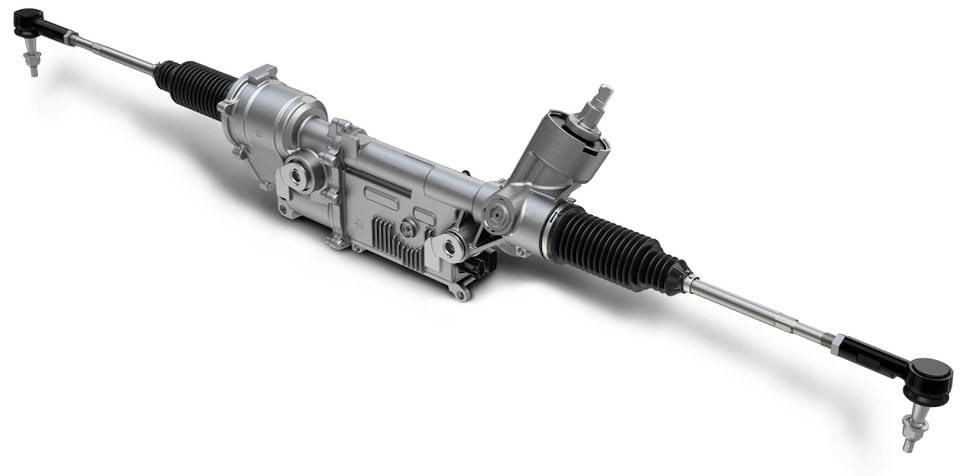
Рулевая рейка: что это такое и как работает
Содержание
Любой автомобиль состоит из нескольких ключевых систем, без которых либо запрещена его эксплуатация, либо у водителя это не получится. Среди таких систем – рулевое управление. Ключевой узел данной системы – рулевая рейка.
Рассмотрим подробней ее устройство, принцип работы, разновидности усилителей, а также некоторые распространенные неисправности механизма.
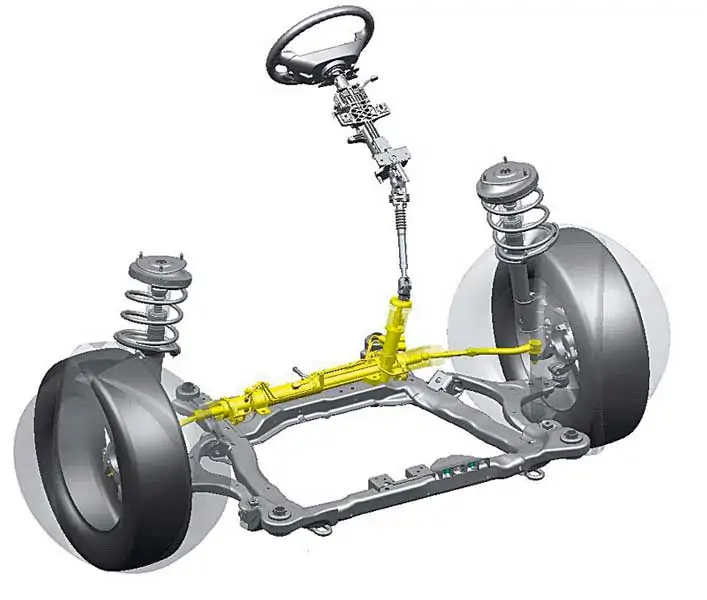
История создания рулевого усилителя
Первые представители четырехколесного транспорта имели примитивное рулевое управление. Поворотные колеса были закреплены на одной балке, которая крепилась к кузову только в центральной части на шарнире – по принципу гужевого транспорта.
Такой механизм не давал возможности самоходным телегам быть маневренными, а радиус разворота был настолько огромным, что полностью развернуться автомобиль мог где-то на площади. Кроме того, для выполнения поворота не требовались усилители рулевого механизма.
Со временем в систему рулевого механизма вносились коррективы, чтобы максимально уменьшить угол разворота авто. Чтобы облегчить задачу для водителя (с каждым разом изобретение делало поворот руля более тугим) разрабатывались всевозможные варианты, начиная от увеличения диаметра самого руля до внедрения в систему разных типов зубчатых передач.
В результате многолетних проб и ошибок инженерами был сделан вывод, что схема рулевой рейки – золотая середина между простотой, доступностью и усилением крутящего момента, поступающего от руля. К тому же такое устройство совместимо с усилителями рулевого управления.
Принцип работы
Рейка в машине представлена в виде планки с зубьями. Она соединена с поворотным механизмом рулевых колес. Она приводится в движение валом рулевой колонки при помощи шестерни или червячной передачи.
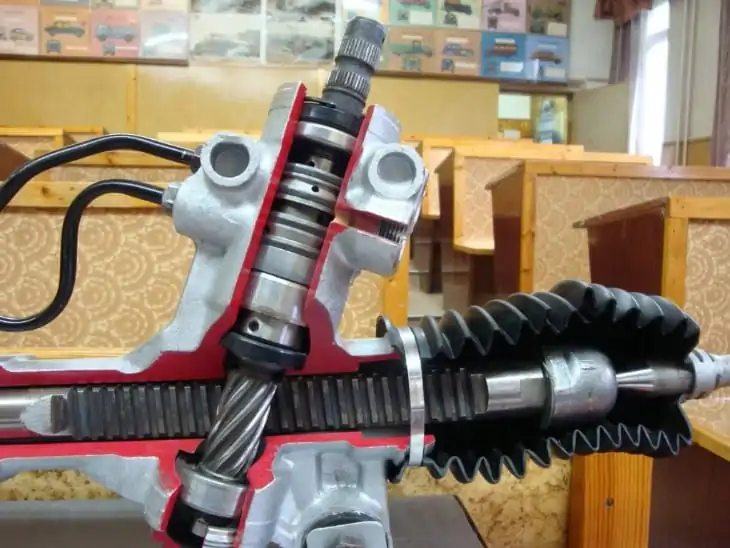
При повороте рулевого колеса шестерня колонки перемещает планку в зависимости от того, в какую сторону вращают руль. На краях планки закреплены рулевые тяги, которые в свою очередь соединены с поворотным шарнирным механизмом каждого из рулевых колес.
Многие современные рулевые рейки дополнительно оснащаются усилителем, облегчающим поворот рулевого колеса. Благодаря внедрению такого механизма комфорт и безопасность в автомобилях повысились.
Устройство и основные составляющие
Чаще всего в автомобилях используется реечная модификация рулевого управления. В устройство такого механизма входят:
- Руль – находится в кабине автомобиля. С его помощью водитель задает направление во время движения машины;
- Рулевая колонка – имеет вид металлического стержня, по которому передается крутящий момент от руля. В целях безопасности этот элемент имеет одну или несколько карданных шарниров (при лобовом столкновении рулевая колонка складывается в нескольких местах, что предотвращает усиление травмы грудной клетки водителя);
- Рулевая планка с зубцами. Эти зубцы зацепляются червячным валом рулевой колонки. Конструкция находится в металлическом корпусе;
- Тяга рулевой рейки – стержни, закрепленные на обоих концах планки при помощи резьбового соединения. На концах тяг имеется резьба, на которую накручиваются наконечники с шарнирами;
- Рулевые наконечники – полая трубка, с одной стороны которой сделана внутренняя резьба (в нее вкручивается стержень рулевой тяги), а с другой – шарнир, соединенный с поворотным кулаком колеса.
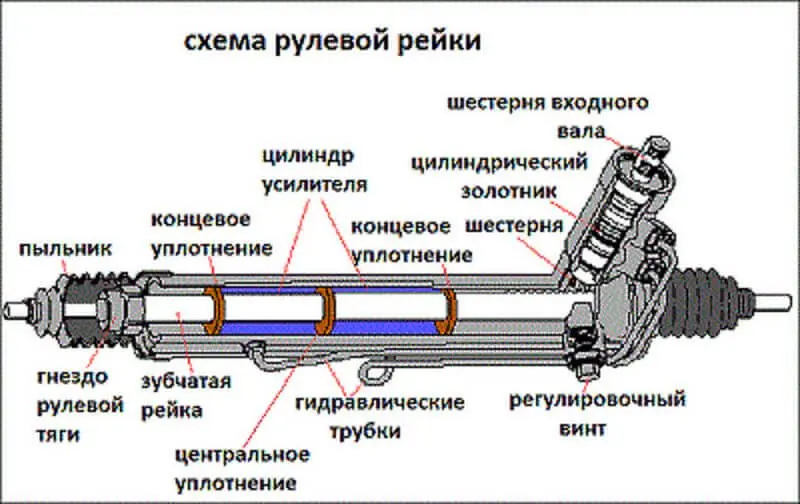
Некоторые модификации рулевых реек оснащаются демпфером. Он расположен между корпусом рейки и тягами. Цель данной детали – гасить вибрации, поступающие от колес, когда машина едет по неровному дорожному покрытию. Чаще всего этот элемент устанавливается в рейках внедорожников.
Типы и варианты исполнения
Как уже было сказано ранее, ключевые элементы рулевой рейки не меняются на протяжении многих десятилетий. В устройство механизма вносятся лишь незначительные коррективы, но принцип остается одинаковым.
Единственное, что отличает все узлы подобного типа – привод усилителя. Всего различают три модификации. Рассмотрим особенности каждой из них.
Механическая рулевая рейка
Данная модификация является классической. Ею оснащались все автомобили до того момента, как были созданы гидравлические и электрические усилители. Механическая рулевая рейка – самый простой тип устройства. Благодаря маленьким зубцам и большим по сравнению с ними рулевому колесу водителю не приходится прилагать большие усилия для поворота автомобиля.
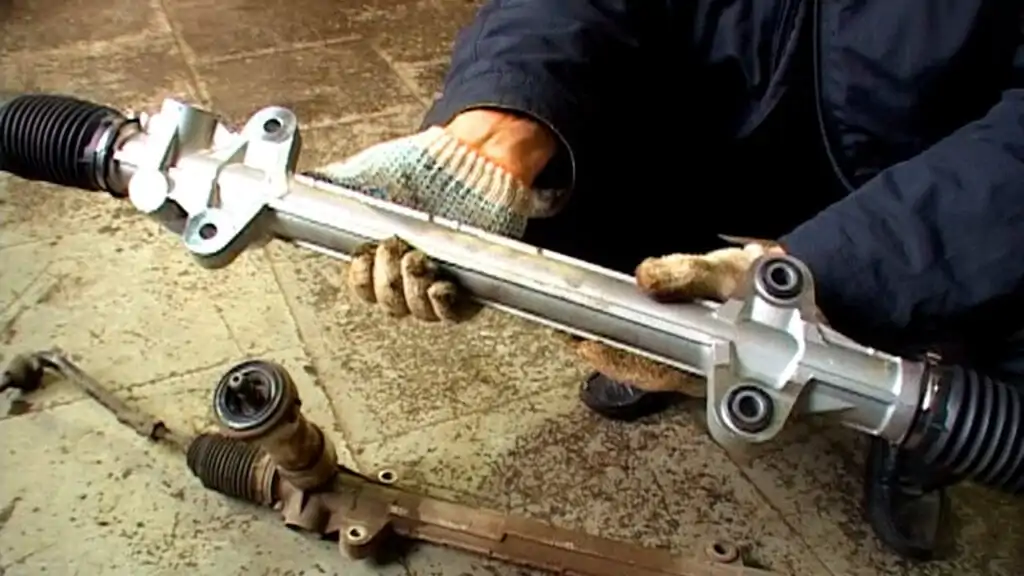
Существуют рулевые рейки с разным передаточным числом. По центру планки сделана зубчатая передача с меньшей амплитудой, а на концах этот показатель увеличивается. Благодаря этому водителю еще легче поворачивать руль во время начала движения или в поворотах на большой скорости. А на парковках, когда колеса нужно выворачивать до упора, водителю не нужно крутить руль по многу раз.
Гидравлическая рулевая рейка
Данная модификация отличается от предыдущей тем, что в ее устройстве имеется дополнительный механизм, который благодаря гидравлическому воздействию. Подробно о принципе работы гидроусилителя читайте здесь.
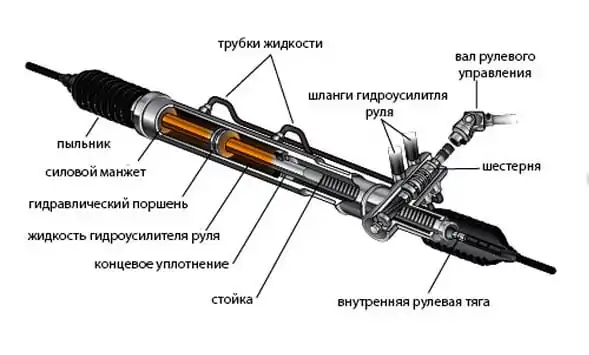
Гидроусилитель обеспечивает плавность и в то же время остроту отзыва рулевой рейки как во время движения на разных скоростях, так и в стоящем на месте автомобиле. Такой усилитель также обеспечивает больше безопасности, когда машина едет по колее. В этом случае шансов, что при попадании на неровность руль выдернет из рук водителя намного меньше.
Электрическая рулевая рейка
Аналогичным усилителем является и электрическая рейка. В ее конструкции вместо гидравлического привода установлен электромотор, усиливающий перемещение планки рулевого механизма.
В бюджетных модификациях электроусилителя мотор стоит в рулевой колонке. Самым безопасным вариантом считаются варианты с электрическим усилителем, установленным в самой рейке. Такая модификация входит в комплектацию премиальных авто.
Первый вариант является самым небезопасным, потому что если усилитель выйдет из строя, машиной практически невозможно будет продолжать управлять.
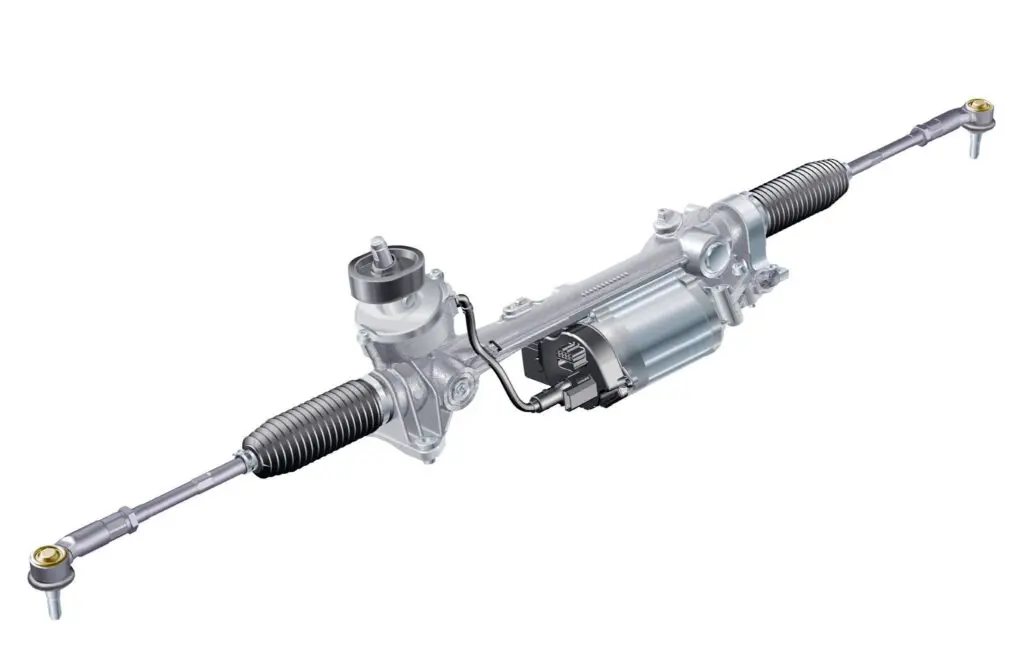
По сравнению с гидроусилителем электрическая рейка имеет несколько преимуществ:
- Больший КПД;
- Меньше расходуется ресурсов автомобиля – в ГУР рабочая жидкость циркулирует постоянно, так как привод насоса подключается к шкиву коленвала и отключается только когда мотор заглушается. Электроусилитель срабатывает только когда поворачивают руль;
- Работа механизма не зависит от температуры воздуха (не нужно прогревать жидкость, чтобы повысить ее текучесть);
- Нужно меньше внимания для обслуживания – нет необходимости следить за уровнем масла, так как механизм работает по другому принципу;
- В устройство входит меньше разных уплотнителей, и отсутствуют шланги, уплотнители, выдерживающие высокое давление. Благодаря этому механизм более надежен, чем ГУР.
Основные неисправности рулевой рейки
О неисправности рулевой рейки свидетельствуют такие признаки:
- Во время езды по дороге с плохим покрытием появляется стук, который пропадает, когда руль поворачивается сильнее;
- Уменьшение или отсутствие усилий при повороте руля или в его центральном положении;
- Руль сам поворачивается;
- После поворота руль туго возвращается в исходное положение или вообще его нужно принудительно поворачивать;
- При малой амплитуде поворота рулевого колеса сами колеса поворачиваются намного сильнее, чем раньше;
- Увеличился люфт руля;
- Увеличилась отдача в руль при передвижении по неровностям;
- Если автомобиль оснащен гидроусилителем, течет жидкость из-под сальника, пыльник или другие элементы механизма имеют масляное загрязнение.
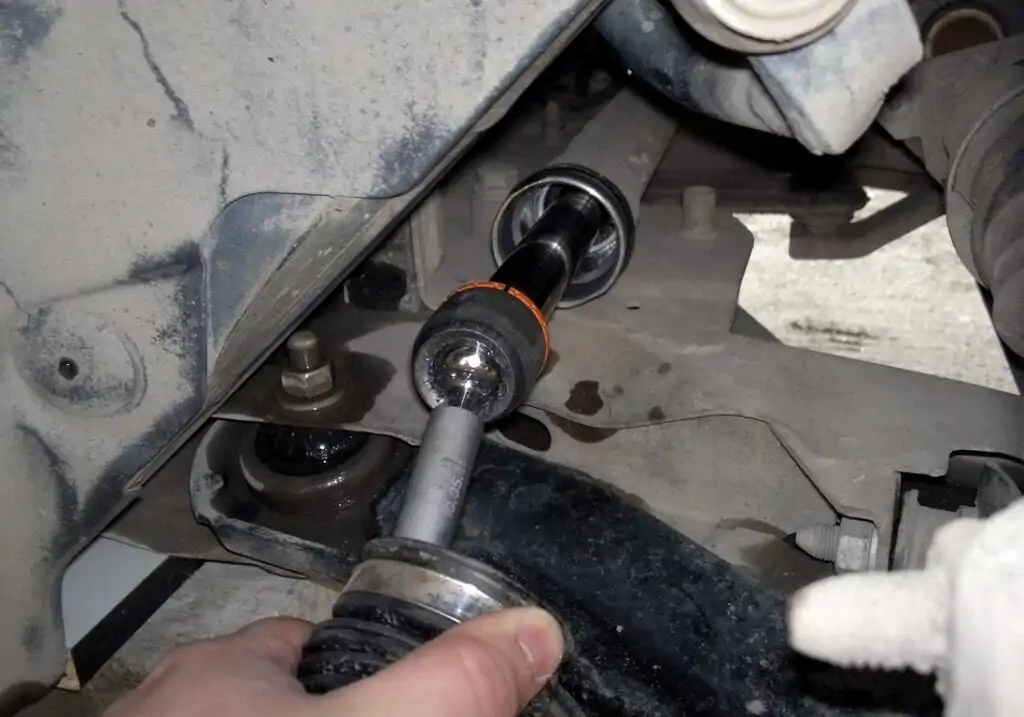
При появлении хотя бы одного из перечисленных признаков следует незамедлительно провести диагностику устройства и провести его ремонт. Часто достаточно приобрести ремкомплект, и заменить все уплотнители, прокладки и пыльники, чтобы устройство начало исправно работать.
Вот самые распространенные поломки рулевой рейки и варианты ремонта:
| Неисправность | Как устранить |
| Выработка на зубцах планки или в червячном валу | Восстановление таких элементов невозможно, поэтому их меняют на новые |
| Поломка корпуса рейки | Механизм заменяется полностью |
| Разрушение пыльников (внутрь механизма попадает грязь с песком, что приводит к выработке или ржавению металлических деталей) | Замена уплотнительных материалов из ремкомплекта |
| Деформация или поломка рулевых тяг или наконечников | Поврежденные детали заменяются |
| Износилась или сломалась втулка, из-за чего появился люфт в рулевой колонке | Замена втулки |
Дополнительно о поломках и вариантах ремонта рулевых реек рассказывается в видео:
Профилактика неисправностей
Рулевая рейка – достаточно надежный и стабильный механизм. Его поломки происходят чаще всего либо из-за неправильной эксплуатации транспортного средства, либо в результате несоблюдения регламента планового обслуживания.
Чтобы продлить срок службы данного механизма, следует придерживаться несложных правил:
- Во время езды по неровным дорогам снижать скорость автомобиля, чтобы в рулевой механизм поступало меньше ударов;
- Оставлять припаркованную машину с прямо расположенными колесами;
- Не поворачивать руль до упора (если имеется ГУР, то будет слышен писк или гул от насоса усилителя), и не удерживать его в таком положении дольше 5сек.;
- Вовремя менять масло в бачке гидроусилителя, контролировать уровень этой жидкости;
- Периодически производить визуальный осмотр пыльников и уплотнителей;
- Прогревать гидроусилитель, поворачивая пару раз в обе стороны руль перед началом движения.
Исправная работа рулевой рейки напрямую влияет на безопасность во время движения авто, поэтому нельзя игнорировать тревожные сигналы, свидетельствующие о неисправностях механизма.
Вопросы и ответы:
Что такое рулевая рейка? Это механизм, с помощью которого крутящий момент передается от рулевого колеса на поворотный кулак рулевых колес. Рулевая колонка преобразует вращательные движения в прямолинейные.
Что будет, если рулевая рейка сломается? Неисправности рулевой рейки приводят к чрезмерному люфту руля, что чревато аварийной ситуацией на дороге. С неисправной рулевой рейкой теряется маневренность машины.
Сколько ходит рулевая рейка? Это зависит от ее конструкции: какой в ней стоит усилитель, какого типа передача используется. Некоторые отхаживают 70-80 тысяч, а другие и по 150 000 исправно работают.
